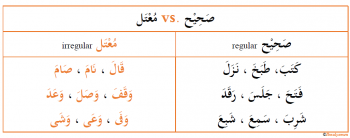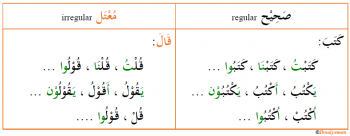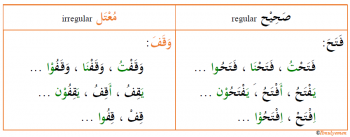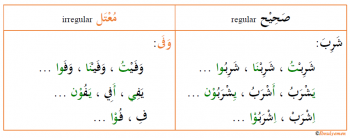Arabic Verb Forms [Regular vs. Irregular] Posted by Ibnulyemen اِبْنُ اليَمَن on May 25, 2017 in Arabic Language, Grammar, Vocabulary
In an earlier post, I classified Arabic Verb Forms based on their root structure into simple and complex. Likewise, based on whether their internal structure changes as they are conjugated with tenses, person, gender, or number, Arabic Verb Forms can be classified into regular and irregular, i.e. صَحِيْح and مُعْتَل.
Put simply, as is illustrated in Figure 1, صَحِيْح is one that does not include a weak letter حَرْفُ العِلَّة. However, مُعْتَل is one that has one (or more) weak letter, verb-initially, -medially, or -finally.
So, how does this matter?
Well, صَحِيْح is easy to use; that is, no problems faced as far as conjugation is concerned. You simply added the affixes that indicate tense, person, or number. It is also safe to generalize the rules of صَحِيْح from one verb to another. مُعْتَل, nevertheless, is full of irregularities with respect to conjugation with tense, person, gender, and number. Therefore, it is oftentimes avoided by learners when they speak the language.
Looking at Figure 2, you can see that all forms of صَحِيْح retain the basic form. Affixes, or letters of addition, that indicate tense, person, or number are simply appended to the start or end of the basic form of the verb. This is the beauty of the صَحِيْح.
Conversely, the مُعْتَل appears a bit puzzling. Line 1 under مُعْتَل represents the past tense form with 3 different persons. At first glance, you can see that the shape of the verb does not look like the basic form (in orange color). In the first two forms, the weak letter حَرْفُ العِلَّة is dropped. In the third form, حَرْفُ العِلَّة is retained but has a different shape. Line 2 represents the present tense forms with 3 different persons. Here, the basic form قَالَ is retained but حَرْفُ العِلَّة has changed from ا to و. In line 3, which represents the imperative form, similar changes are observed.
What is going on? What causes these changes? Let’s look at other types of مُعْتَل before examining this.
In Figure 3, the صَحِيْح behaves as above. The مُعْتَل, which is different from the مُعْتَل in Figure 2 in the position of حَرْفُ العِلَّة, i.e. weak letter is first letter, behaves equally strangely. In the past form conjugation, no change occurs. In the present form, line 2, حَرْفُ العِلَّة is dropped before adding the tense and number affixes are added. Similarly, حَرْفُ العِلَّة is dropped in the imperative form.
Now let’s look at yet another type of مُعْتَل. In Figure 4, the صَحِيْح continues to behave the way we want. The مُعْتَل, however, seems a bit messy. Its messiness is because of having two weak letters, i.e. و and ى. In line 1, the ى, which is a variant of alif ا, changes to ي in the first two forms and gets dropped in the last. In line 2, the و is dropped from all three forms, just as in Figure 3. Interestingly, only one letter remains from basic form in the third conjugation. Similarly, the imperative form has lost both weak letters of the basic form. Puzzlingly interesting!
Now let’s disentangle the puzzling behavior of the مُعْتَل. Why does it lose weak letters? Pay extra attention to this and apply it to any weak-letter droppings in both verbs and nouns you may come across henceforth.
In Figure 1, قَالَ loses the ا and become قُلْتُ. Following the rule of the صَحِيْح, قَالَ should be conjugated as قَالْتُ, right? Now look at قَالْتُ more closely. The ا and the ل both have sukoon on them. However, two consecutive sukoons in Arabic are prohibited (this is a rule). How is this resolved? The first letter with the sukoon gets dropped. This rule is applicable across the board. How about يَقُوْلُ, why does the ا changes to و? Well, this relates to the basic form of قَالَ. It is not قَالَ; rather, it is قَوَلَ and the و changes to ا due to internal diacritical marks. Let’s leave it at this for now. I will talk about this when dealing with types of nouns and noun-formation.
To explain further, let’s examine قُلْ in Figure 1. قُلْ is the imperative form, and as you know imperative forms are derived from the present form يَقُوْلُ. Here is how it works.
- Drop يـ of the present = قُوْلُ
- Assign sukoon to the end of imperative, as imposed by the grammar = قُوْلْ
- قُوْلْ has two sukoons
- Drop first letter with sukoon, as per the rule above = قُلْ which is the final form.
In the case of فِ in Figure 4, the present form should be يُفِي. Here is what happens.
- Drop the يـ of the present = فِي
- Assign sukoon to the end of imperative = فِيْ ْ
- فِيْ ْ had has two sukoon on the last letter, so drop the letter altogether = فِ which is the final form.
Vocabulary:
| كَتَبَ ‘to write’ | طَبَخَ ‘to cook’ | نَزَلَ ‘to come down’ | فَتَحَ ‘to open’ |
| رَقَدَ ‘to sleep’ | شَرِبَ ‘to drink’ | سَمِعَ ‘to hear’ | شَبِعَ ‘to be full of food’ |
| نَامَ ‘to sleep’ | صَامَ ‘to fast’ | وَقَفَ ‘to stand’ | وَصَلَ ‘to arrive’ |
| جَلَسَ ‘to sit’ | قَالَ ‘to say’ | وَعَدَ ‘to promise’ | وَفَى ‘to fulfil a promise’ |
| وَعَى ‘to realize’ | وَشَى ‘to betray’ |
Now try conjugating the verbs in Figure 1 in the same way as in Figures 2, 3, and 4.
Questions are appreciated, if any, post them in the comment section.

Build vocabulary, practice pronunciation, and more with Transparent Language Online. Available anytime, anywhere, on any device.







